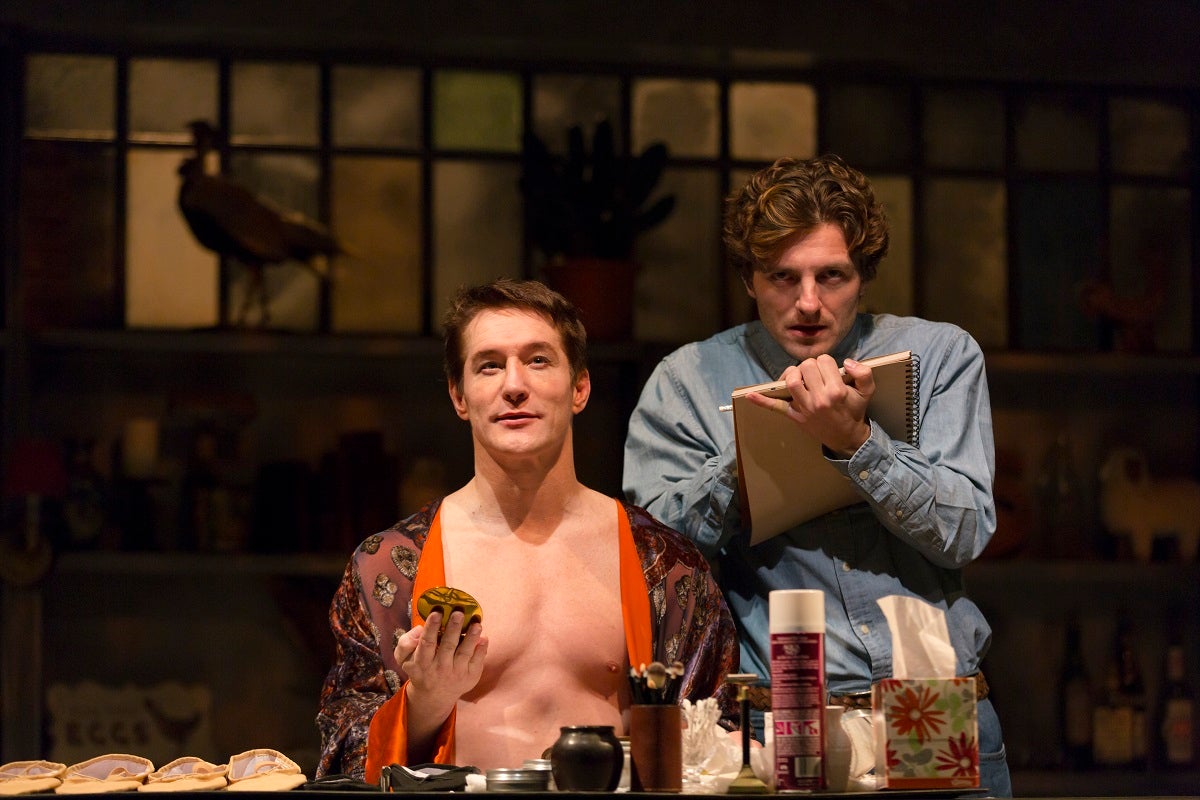Delaware Theatre Company’s latest production relives enduring friendship

Bill Dawes (left) plays dancer Rudolf Nureyev and William Connell (right) as Jamie Wyeth in "Nureyev's Eyes
Based on a true story, playwright David Rush delves into a complex kinship in “Nureyev’s Eyes.”
Was the unlikely camaraderie that developed between artist Jamie Wyeth and dancer Rudolf Nureyev the result of opposites attracting or a case of kindred spirits coalescing?
True, the differences are monumental: Nureyev was gay, Wyeth straight. Nureyev was self-assured and vain; Wyeth uncertain and self-deprecating. Nureyev was a critical success; Wyeth the critical oddity of his storied heritage.
But the similarities cut deeper: both men were consummate artists. Both had troubled relationships with their fathers. Both would accept nothing less than perfection. Both abhorred rejection. Both struggled with a deep-seated fear.
It is the bond that formed through those shared experiences between painter and painted that David Rush explores in his new play, “Nureyev’s Eyes,” now on stage at the Delaware Theatre Company through March 20.
The story is a true one. Beginning in the mid-1970s, Wyeth made scores of sketches and paintings of Nureyev. During that period, the men developed a friendship that endured until 1993 when Nureyev died of complications from AIDS at the age of 55.
Rush offers a thought-provoking—if somewhat formulaic—account of how that friendship may have developed.
The opening scene finds the men at a party in a tony apartment in New York City. The affable Wyeth (William Connell) approaches the haughty Nureyev (Bill Dawes) with his request to paint his portrait and gets a chilly reception. But there’s actually a quid pro quo at work here: Nureyev—at least in Rush’s narrative—longs to replace George Balanchine as head of the New York City Ballet. Wyeth is friends with Lincoln Kirstein, the head of the company. Each man hopes to leverage the situation to his advantage.
Nureyev sits for Wyeth at various times in various locations while Wyeth produces sketch after disappointing sketch. The meetings become testy. Nureyev grows frustrated with Wyeth; Wyeth grows frustrated with himself.
But the time they spend together offers them the opportunity to reach deep into each other’s psyche, to drill down into the bedrock of their very essence. They find their way using riddles: How is Jamie like the KGB or a shark or a Puccini opera? How is Rudy like vodka or a Siberian bear?
The dialogue is crisp and quick, punctuated with bouts of rage and passion. But as they learn more and more about each other—and themselves—the interaction grows warmer and more empathetic.
Nureyev initially bristles when Wyeth asks about his relationship with Danish-born dancer Eric Bruhn, with whom Nureyev shared 25 tumultuous years. But later, in one of the most poignant scenes of the play, Nureyev shares with Wyeth his grief after a hospital visit with Bruhn, who is now dying of lung cancer. He reproaches himself for failing to kiss Bruhn goodbye when he left the hospital and vows not to forget tomorrow. After he exits Wyeth’s studio, the phone rings. There would be no next time.
The characters also share their greatest fear. For Nureyev, it is the KGB, whose agents he knows are following him after his defection to the West. For Wyeth it is darkness, a childhood fear brought on by a painting in which N.C. Wyeth presents a frightening image of “blind Pew,” a character in the Robert Louis Stevenson novel “Treasure Island.”
Wyeth recalls his reaction as a six-year-old child. “That night after they tucked me in all cozy and cute and turned out the light,” he says. “I started to scream and it was all night light after that for years.”Nureyev replies that his fear is rooted in reality, while Wyeth’s is in his imagination.
Conflicting personalities make for exciting drama, even though we can’t possibly know which elements are real and which are the products of the playwright’s fertile imagination and deductive capabilities.
Both actors deliver convincing and nuanced performances under the direction of Michael Mastro. Dawes presents a formidable Nureyev. While not a dead ringer for the dancer, he nevertheless conjures up his essence with appropriate facial expressions, poses and gestures. His Russian accent is convincing, although at times tough to understand. Dawes also demonstrates Nureyev’s grace and passion—if not his artistry—in the dance scenes choreographed by Charlie Williams.
Connell has the more difficult role in that he must play straight man to Dawes’ histrionics and diva behavior. And it is Connell who reins in the turbulence and provides perspective, delivering the opening and closing lines of the play.
Still one wishes that Rush had provided some insight into Wyeth’s views on the primal sources of his art. One of the most dramatic scenes of the play has Nureyev ruminating and demonstrating what motivated the first caveman to dance.
The action unfolds on Alex Distler’s flexible setting which appropriately centers on Wyeth’s studio and all the accoutrements of the trade. It is encased in a frame filled with attractive bric-a-brac. It falls to Connell to “change” the scenery by moving a large desk set on casters.
If “Nureyev’s Eyes” has any shortcomings, it is that Rush tells us more about Nureyev than he does about the man who painted him. The story line too is largely formulaic. But these are minor flaws in a work that reveals much about the art world and the people who inhabit it.
WHYY is your source for fact-based, in-depth journalism and information. As a nonprofit organization, we rely on financial support from readers like you. Please give today.

